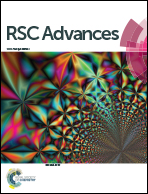A stereoregular macrocyclic oligomeric silsesquioxane bearing epoxide groups: synthesis and its nanocomposites with polybenzoxazine
Abstract
In this contribution, we report the synthesis of cis-hexa[(phenyl)(dimethylsiloxypropylglycidylether)cyclohexasiloxane, a novel macrocyclic oligomeric silsesquioxane (MOSS) via the combination of silylation and hydrosilylation reactions. This stereoregular MOSS macromer bearing epoxide groups was then incorporated into polybenzoxazine (PBZ) thermoset and the organic–inorganic nanocomposites were successfully obtained as evidenced by scanning electron microscopy (SEM) and transmission electron microscopy (TEM). Dynamic mechanical thermal analysis (DMTA) showed that the organic–inorganic nanocomposites displayed enhanced glass transition temperatures (Tg's) compared to plain PBZ. Thermogravimetric analysis (TGA) indicates that the organic–inorganic PBZ nanocomposites possessed improved thermal stability. The improved thermomechanical properties are attributable to the nanoreinforcement of the stereoregular macrocyclic silsesquioxanes on PBZ matrix as well as the additional crosslinking between PBZ and the MOSS macromer. The results of static contact angle measurement showed that the surface hydrophobicity of the organic–inorganic nanocomposites was significantly improved compared to the plain PBZ thermoset.


 Please wait while we load your content...
Please wait while we load your content...